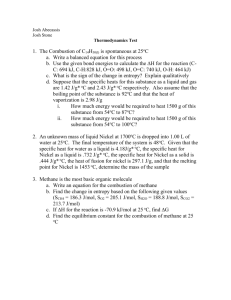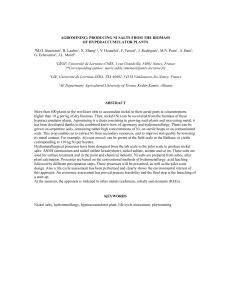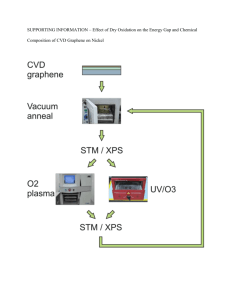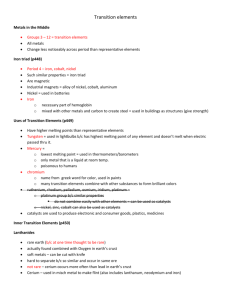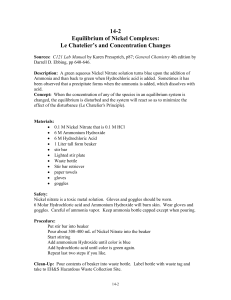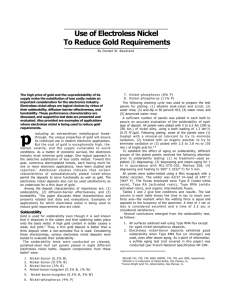Lab 22: Electroplating Nickel - Tri
advertisement
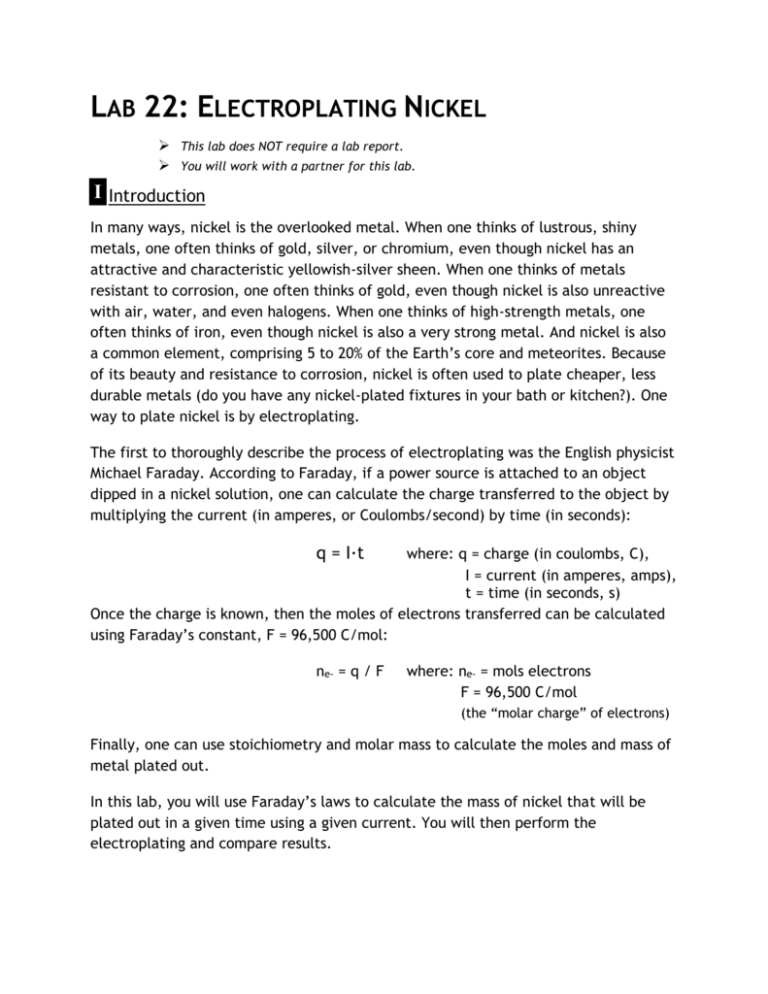
LAB 22: ELECTROPLATING NICKEL This lab does NOT require a lab report. You will work with a partner for this lab. I Introduction In many ways, nickel is the overlooked metal. When one thinks of lustrous, shiny metals, one often thinks of gold, silver, or chromium, even though nickel has an attractive and characteristic yellowish-silver sheen. When one thinks of metals resistant to corrosion, one often thinks of gold, even though nickel is also unreactive with air, water, and even halogens. When one thinks of high-strength metals, one often thinks of iron, even though nickel is also a very strong metal. And nickel is also a common element, comprising 5 to 20% of the Earth’s core and meteorites. Because of its beauty and resistance to corrosion, nickel is often used to plate cheaper, less durable metals (do you have any nickel-plated fixtures in your bath or kitchen?). One way to plate nickel is by electroplating. The first to thoroughly describe the process of electroplating was the English physicist Michael Faraday. According to Faraday, if a power source is attached to an object dipped in a nickel solution, one can calculate the charge transferred to the object by multiplying the current (in amperes, or Coulombs/second) by time (in seconds): q = I∙t where: q = charge (in coulombs, C), I = current (in amperes, amps), t = time (in seconds, s) Once the charge is known, then the moles of electrons transferred can be calculated using Faraday’s constant, F = 96,500 C/mol: ne- = q / F where: ne- = mols electrons F = 96,500 C/mol (the “molar charge” of electrons) Finally, one can use stoichiometry and molar mass to calculate the moles and mass of metal plated out. In this lab, you will use Faraday’s laws to calculate the mass of nickel that will be plated out in a given time using a given current. You will then perform the electroplating and compare results. Equipment and Reagents 150-mL beaker Carbon rod (to be used as anode) Power source 3 wire leads with clips Ammeter Stopwatch Analytical balance Nickel plating solution Metal object to be electroplated ! Warnings! The nickel plating solution is very concentrated and toxic. Do not ingest and immediately report any spills to Mr. Benter. We are working with electricity. Although the power produced by the power supply box is relatively safe (it’s low voltage DC current, the same as from batteries), common-sense precautions should be taken. Do NOT short circuit the power supply by touching the (+) and (-) wires together. Procedure 1) Set up your lab notebook. 2) Get a 150-mL containing the nickel plating solution. The solution contains concentrated nickel(II) sulfate and boric acid (H3BO3, used to create a buffer to maintain a desirable pH). 3) Weigh and record the mass of the object to be plated. Using steel wool, polish your object first and then weigh it on an analytical balance. 4) Set up the circuit. Make sure the power supply is OFF when making these connections (from an error requirement, not a safety requirement) Connect one wire to the black (-) terminal of the power supply. This is the cathode, the source of electrons for your circuit. Connect the other end of this wire to the object to be plated. Connect a second wire to the red (+) terminal of the power supply. This is the anode, the “drain” where electrons will go when they return from your circuit. Connect the other end of this wire to the red terminal of the ammeter. (WAIT A MINUTE!!! What’s an ammeter???? An ammeter is a tool used to measure the current (amps) running through a circuit) Attach the third wire to the black terminal of the ammeter. Connect the other end of this wire to the carbon rod. 5) Insert your electrodes into the solution. Make sure the electrodes are not touching each other! 6) Adjust the power supply. Start with the voltage and current set to zero (as far to the left as the knobs will go). Have your timer ready. 7) Start electroplating. Turn the power supply on. Turn up the voltage about ¼ way. Turn up the current until the ammeter reads 0.5 amps. Immediately begin timing. 8) Electroplate for 10.0 minutes. Time carefully! Observe and record your observations. 9) Perform your calculations. While you’re waiting 10.0 minutes, calculate the mass of nickel that will be electroplated on your object. 10) Remove your object. Carefully rinse in tap water, followed by acetone. Allow to air dry. 11) Weigh and record the mass of your nickel-plated object. 12) Determine the mass of nickel plated on your object. Calculate your percent error. 13) As time permits, feel free to nickel-plate other objects of interest. Think of them as keepsakes of your fond times in AP Chemistry… Data and Calculations (to be recorded on your lab Data Sheet) Procedure, observations, and masses of object before and after Expected mass of electroplated nickel, with supporting calculations Actual mass of electroplated nickel and percent error ? Questions to Answer None!


